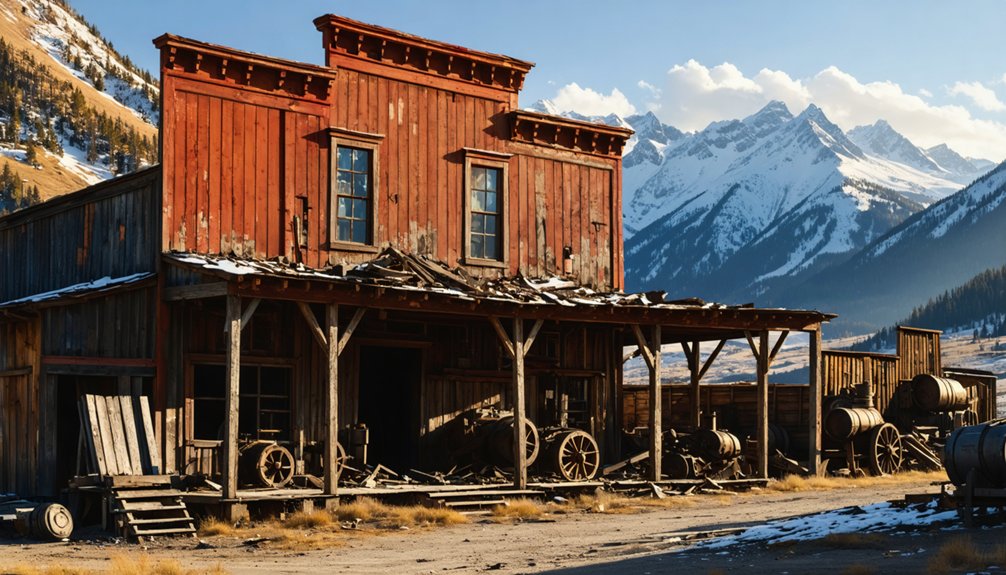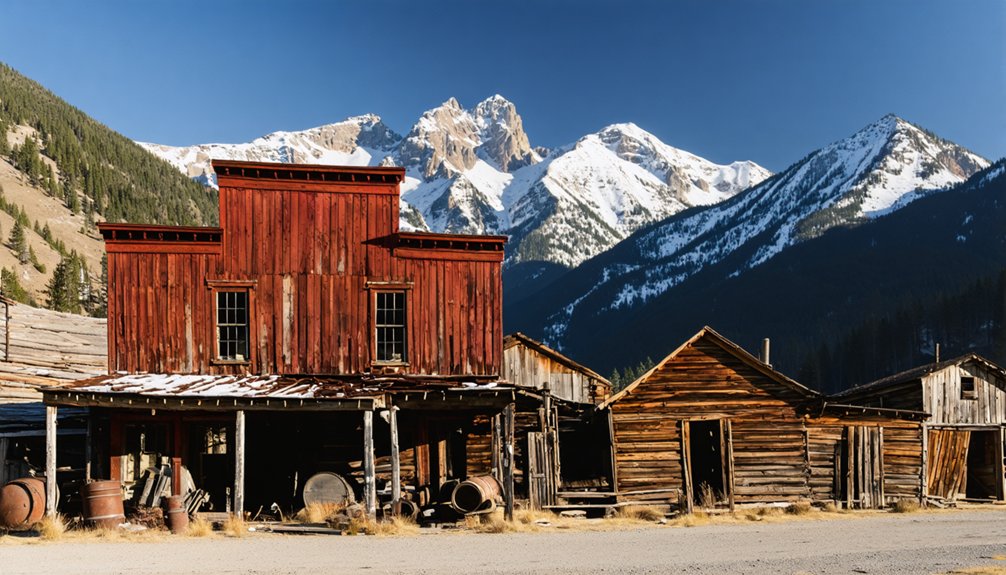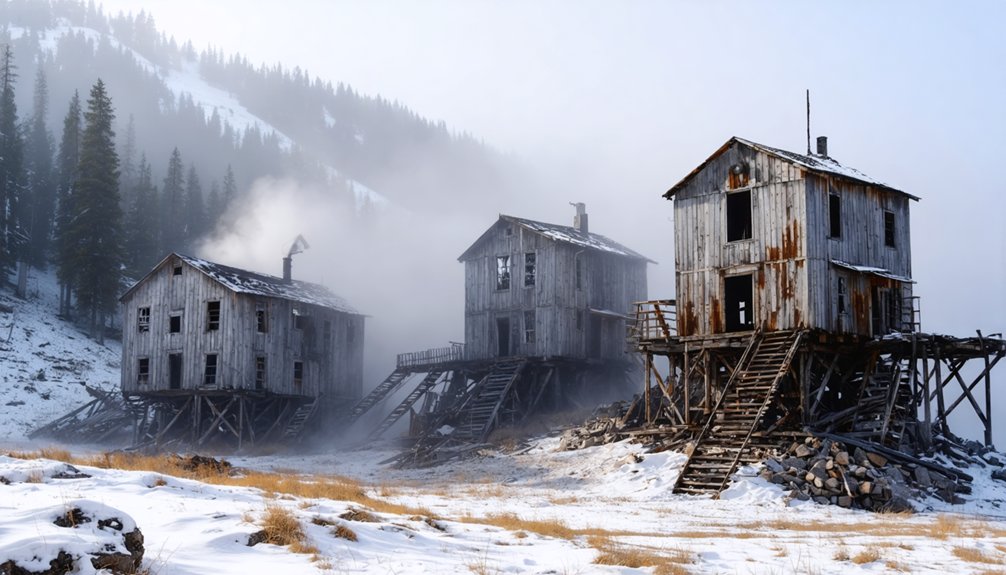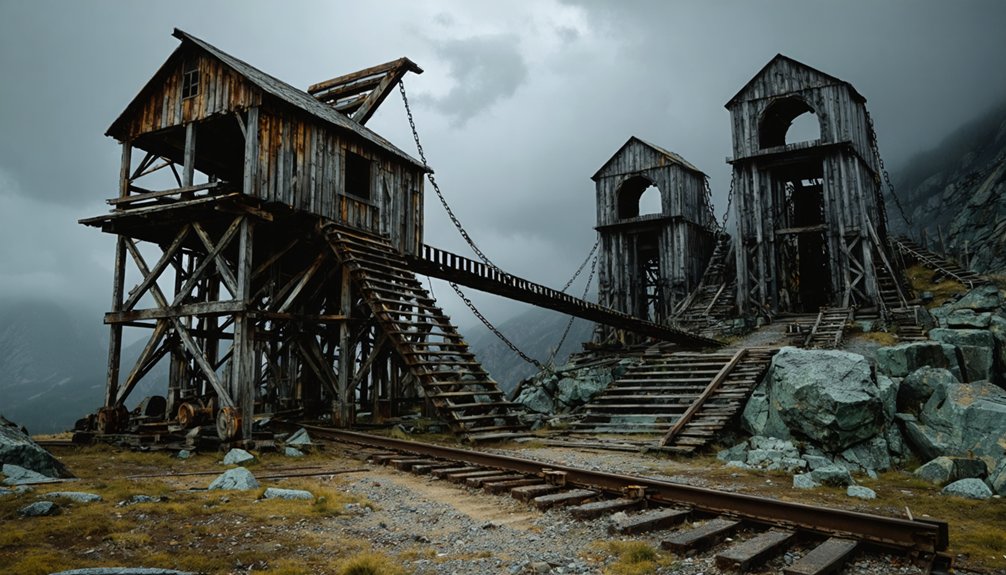Colorado’s ghost towns showcase the dramatic boom-and-bust mining era with seven standouts: Freeland, St. Elmo, Irwin, Ironton, Goldfield, Winfield, and Independence. You’ll find remarkably preserved Victorian structures, restored log cabins, and abandoned mining equipment throughout these historical sites. At 9,961 feet, St. Elmo remains the best-preserved with 43 original buildings, while others offer unique perspectives on frontier economics and resilience. These mountain settlements reveal deeper stories of Western ambition and ultimate abandonment.
Key Takeaways
- St. Elmo remains Colorado’s best-preserved ghost town with 43 original structures from the 1880s mining boom.
- Freeland yielded at least $18 million in ore by 1952 before becoming one of Colorado’s notable mining ghost towns.
- Ironton served as a critical transportation hub between Ouray and mining camps before its eventual abandonment.
- Goldfield boomed to 3,000 residents after an 1894 gold strike but collapsed when the Portland Mine failed.
- Winfield features original log structures including a schoolhouse that now serves as a museum of mining history.
Freeland: A Clear Creek Mining Legacy
Nestled in the rugged terrain of Clear Creek County about 4 miles west of Idaho Springs, Freeland stands as a tribute to Colorado’s rich mining heritage. Established around 1878 near Trail Creek, this once-thriving settlement peaked in the 1880s with 400 residents before fading into ghost town history by the early 20th century.
Forgotten Colorado towns like Freeland whisper stories of mining booms, frontier dreams, and the relentless passage of time.
The Freeland mining operations were remarkably productive, with the Freeland vein—discovered in 1861—becoming one of Clear Creek County’s richest producers. This area shares historical significance with Boulder County’s Cardinal, which gained notoriety as a center for less reputable enterprises away from neighboring communities. The mines in this region typically reached average depths of 200 feet, representing the era’s shift from surface exploration to deeper operations.
By 1952, the district had yielded ores worth at least $18 million, extracting gold, silver, copper, lead, and zinc. The main Freeland mine alone produced an estimated quarter-million dollars in precious metals.
Today, you’ll find scattered remains where 80 buildings once stood—silent witnesses to the boom-and-bust cycle that defined Colorado’s mining frontier.
St. Elmo: Colorado’s Best-Preserved Ghost Town
You’ll find St. Elmo remarkably intact among Colorado’s ghost towns, with forty-three original structures still standing from its 1880s mining heyday.
Its well-preserved buildings, including the general store, hotels, and mining infrastructure, offer visitors an authentic glimpse into the town’s boom period when nearly 2,000 residents pursued gold and silver fortunes.
The town’s accessibility at 9,961 feet elevation in the Sawatch Range has transformed it into a popular mountain tourism destination, particularly after the Denver, South Park & Pacific Railroad grade was converted into a road following the tracks’ removal in 1926. The surrounding area features 150 patented mines that once fueled the town’s economic prosperity. Local legend suggests that Annabelle Stark’s spirit still watches over the town, protecting it from vandals and contributing to its haunted reputation.
Well-Preserved Historic Buildings
A tribute to Colorado’s mining heritage, St. Elmo boasts approximately 40 original Victorian-era structures that transport you back to the 1880s.
Despite a devastating 2002 fire that claimed the Town Hall and Jail, numerous significant buildings remain intact, including the American House Hotel, schoolhouse, and blacksmith shop.
The Victorian architecture throughout the town exemplifies typical mining town construction with wood-frame designs and practical steel roofs engineered for harsh mountain conditions.
Many buildings have been meticulously restored with period furnishings, offering authentic glimpses into frontier life. The general merchandise store continues to operate seasonally from May to October, allowing you to experience living history. St. Elmo sits at an elevation of 9,961 feet in the scenic Sawatch Mountain Range.
The town once had a peak population of 2,000 during the mining boom of the 19th century before economic decline and fires led to its abandonment.
The Stark family descendants deserve recognition for their preservation efforts, donating structures that showcase the remarkable craftsmanship of Colorado’s mining heritage.
Mountain Tourism Destination
Once a thriving mining community, St. Elmo now stands as an accessible mountain tourism destination at nearly 10,000 feet elevation in Colorado’s Sawatch Range.
You’ll find this remarkably preserved ghost town about 20 miles southwest of Buena Vista, nestled among fir-studded slopes and impressive mountain vistas.
The surrounding backcountry terrain offers numerous mountain activities, from hiking and horseback riding to ATV exploration along the historic Alpine Tunnel railroad grade.
Scenic views abound, with Mt. Antero’s 14,000-foot peak dominating the landscape and Chalk Creek Canyon providing dramatic natural backdrops.
Visitors can explore 43 surviving structures, including the restored schoolhouse and town hall, experiencing the authentic remnants of Colorado’s mining heritage while enjoying the rugged freedom of high-altitude wilderness adventures. The town’s historical significance was officially recognized when it was listed as a national historic district in 1979, leading to ongoing preservation efforts.
Irwin: The Short-Lived Silver Boomtown
While most Colorado mining towns enjoyed decades of prosperity, Irwin’s meteoric rise and fall stands as one of the state’s most dramatic boom-and-bust narratives.
Discovered in 1879 in Gunnison County’s Elk Mountains, this silver mining settlement—also known as Ruby Camp—quickly absorbed neighboring camps and became the district’s hub.
You’ll find Irwin’s timeline shockingly compressed: by 1884, it had transformed from one of Colorado’s largest camps to a quiet mountain outpost.
The 1893 repeal of the Sherman Silver Purchase Act devastated the local economy. Despite a three-year drainage project, the town couldn’t recover.
Similar to Ironton, sulfide ore issues plagued mining operations and contributed to the decline of this once-thriving community.
Wildfires and heavy snowfall gradually destroyed remaining buildings, erasing its physical presence. The story of this vanished boomtown was documented by Muriel Sibell Wolle in her comprehensive 1947 Colorado Magazine article about mining ghost towns.
Ironton: Transportation Hub Turned Ghost Town
Unlike Irwin’s fleeting existence, Ironton emerged as a more enduring presence in Colorado’s mining landscape, though it ultimately shared the same ghostly fate.
Originally known as Copper Glen, this strategically positioned settlement transformed the mining logistics of the Red Mountain District after its 1884 establishment.
You’ll appreciate how Ironton’s flat valley terrain facilitated rapid development, with over 300 buildings appearing within months.
Otto Mears’ toll road completion catapulted the town into transportation evolution, establishing it as the vital supply nexus between Ouray and neighboring mining camps. Daily trains from Silverton further cemented its commercial importance.
The settlement was renamed Ironton after the low-grade iron ore found in the area when the post office was established.
Despite surviving the 1893 Silver Panic through gold discoveries and the ambitious Joker Tunnel project, Ironton gradually succumbed to resource depletion.
Goldfield: Rise and Fall of a Productive Mining Community

Born from a fortuitous gold strike in 1894, Goldfield emerged as one of Colorado’s most productive mining communities when three prospectors—James Doyle, James Burns, and John Harnan—discovered rich deposits at what would become the Portland Mine.
The settlement quickly transformed from a fire-scarred pasture into a thriving union town of 3,000 residents.
Unlike its surviving neighbors Victor and Cripple Creek, Goldfield’s mining legacy was cut short by its fatal dependence on a single economic driver.
When the Portland Mine faltered, the town collapsed with it.
Today, you’ll find only scattered remnants along County Road 81, approximately one mile north of Victor.
These deteriorating structures stand as silent witnesses to Goldfield history—a stark reminder of how quickly prosperity can vanish in single-resource economies.
Winfield: The 120-Acre Mining Settlement
If you travel to the junction of Clear Creek’s north and south forks in Chaffee County, you’ll discover Winfield, a 120-acre mining settlement established in 1881 where the population once reached approximately 1,500 residents during its 1890 peak.
The town’s infrastructure included three saloons, multiple stores, hotels, and essential services before declining after the 1893 silver crash.
Today, you can still explore several original log structures in the Clear Creek Canyon, including the preserved schoolhouse and Ball Cabin, which serve as museums maintained by the Clear Creek Canyon Historical Society.
Discovery and Peak Population
While prospectors first built a cabin in the Winfield area as early as 1861, the settlement that would later become one of Colorado’s bustling mining communities didn’t take formal shape until nearly two decades later.
The discovery timeline accelerated in 1867 with initial prospecting, though the town wasn’t officially platted until 1880/1881.
Originally known as Lucknow or Florence, Winfield’s silver mining boom transformed the settlement rapidly.
You’d have found the town strategically positioned at the junction of Clear Creek’s north and south forks, spread across 120 acres. The founders smartly offered free lots to anyone willing to build, sparking rapid growth.
Clear Creek Canyon Remains
Today, nestled within the rugged terrain of Clear Creek Canyon, the historic remains of Winfield stand as a memorial to Colorado’s mining legacy.
As you explore this well-preserved 120-acre settlement, you’ll discover several original structures that survived the silver bust of 1893 which devastated Winfield’s economy.
The restored schoolhouse now functions as a museum operated by the Clear Creek Canyon Historical Society, while the Ball Cabin showcases authentic mining-era artifacts.
Just a quarter mile north, you’ll find the cemetery with 26 graves—most unmarked except for the Aude children—revealing the harsh realities of frontier life.
The last ore left Winfield in 1918, ending its tumultuous silver mining history.
Access this piece of Colorado’s past via County Road 390, where freedom-seeking adventurers can camp near Clear Creek bridge.
Colorado’s Mining Heritage: What These Towns Teach Us

Colorado’s mining towns serve as profound historical monuments to the boom-and-bust cycles that characterized Western expansion in the late 19th and early 20th centuries.
These settlements reveal vital lessons about economic vulnerability and community resilience.
You’ll discover how towns that diversified beyond their mining economy survived, while single-industry communities collapsed when resources depleted.
The cultural diversity of these settlements—with immigrants, African Americans, and various ethnic groups—created unique social structures that shaped Colorado’s identity.
When you explore these ghost towns, you’re witnessing cautionary tales about sustainable resource management and environmental stewardship.
The abandoned mines and deteriorating structures remind us that economic prosperity built on finite resources requires planning and diversification.
Today’s preservation efforts demonstrate how communities can transform historical tragedy into cultural heritage and economic opportunity through tourism.
Frequently Asked Questions
Are Any of These Ghost Towns Accessible During Winter Months?
In the most magnificent Colorado adventure, you’ll find winter accessibility varies dramatically. St. Elmo and Alta offer year-round ghost town exploration, while high-elevation sites like Independence remain snowbound, requiring 4×4 vehicles or specialized equipment.
What Paranormal Activities Have Been Reported in These Abandoned Towns?
You’ll encounter ghost sightings in these haunted locations, including apparitions of miners, unexplained sounds, shifting objects, cold spots, and photographic anomalies—especially in Crested Butte, Gilman, and Leadville area towns.
Can Visitors Take Artifacts or Souvenirs From These Sites?
Taking artifacts is a federal felony that’ll land you in prison forever. Artifact preservation maintains historical significance, and removing items over 50 years old violates federal regulations protecting Colorado’s irreplaceable mining heritage.
Are There Guided Tours Available at All Five Locations?
No, not all five locations offer guided tours. You’ll find structured guided experiences at Edgar and Mollie Kathleen mines, while Saint Elmo and Ironton offer self-guided tour options instead.
Which Town Has the Most Dangerous Hiking Trails or Structures?
Based on the information provided, Gilman presents the most significant hazards, combining EPA-closed toxic areas with dangerous trails and extreme structural hazards from contaminated, abandoned industrial infrastructure that’s officially forbidden to visitors.
References
- https://westernmininghistory.com/5833/a-tour-of-colorado-mining-towns/
- https://www.youtube.com/watch?v=SXVTtQjK8lU
- https://www.colorado.com/articles/colorado-ghost-towns
- https://www.denver7.com/news/local-news/colorado-ghost-towns-their-past-present-and-future-in-the-rocky-mountains
- https://en.wikipedia.org/wiki/List_of_ghost_towns_in_Colorado
- https://archives.colorado.gov/collections/historic-mine-reports
- https://www.uncovercolorado.com/ghost-towns/
- https://www.amli.com/blog/abandoned-mines-and-ghost-towns-near-denver
- https://www.coloradoan.com/story/news/2025/10/10/here-are-8-of-colorados-best-ghost-towns-to-visit-in-fall/86579217007/
- https://coloradogeologicalsurvey.org/minerals/historic-mining-districts/



